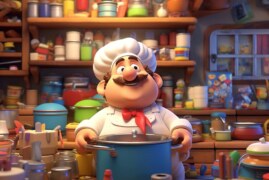Cooking seafood can seem intimidating, especially when it comes to frozen scallops. But don’t let that stop you from enjoying this delicious and nutritious delicacy. Scallops are a great source of protein, omega-3 fatty acids, and essential vitamins and minerals. Plus, they’re versatile and can be incorporated into a variety of dishes. In this article, we’ll show you how to cook frozen scallops like a pro, so you can enjoy their sweet and delicate flavor anytime. Whether you’re a beginner or an experienced chef, our step-by-step guide will make cooking frozen scallops a breeze. So grab a pan and get ready to impress your family and friends with perfectly cooked scallops every time!
1. The Best Ways to Thaw Frozen Scallops Before Cooking
When it comes to cooking frozen scallops, the first and the most important step is to thaw them before cooking. Thawing scallops properly can make a huge difference to the final result. are:
1.1 Thaw scallops in the refrigerator
This is the most recommended method to thaw frozen scallops slowly and safely. All you need to do is to take the scallops out of the freezer and place them in the refrigerator. Depending on the size of the scallops, it can take anywhere from 12 to 24 hours for them to thaw completely. It’s important to note that scallops can release a lot of moisture when thawed via this method, so make sure they’re placed in a bowl or plate to catch any liquid.
1.2 Thaw scallops in cold water
If you’re in a hurry, you can use the cold water method to thaw scallops quickly. Just place the frozen scallops in a ziplock bag and seal it tightly, then place the bag in a bowl of cold water. Change the water every 30 minutes, and within 1 to 1.5 hours, the scallops will be thawed completely. Do not use hot water, as it will partially cook the scallops and alter their texture.
1.3 Thaw scallops in the microwave
Another quick method to thaw scallops is to use the microwave, but we recommend this only as a last resort, as it could result in uneven thawing. Place the frozen scallops in a microwave-safe bowl and cover it with plastic wrap, leaving a small vent to allow steam to escape. Set the microwave on defrost mode and heat the scallops for 30-second intervals until they’re thawed completely. Handle the scallops carefully, since they can become hot and break apart.
In conclusion, whether you choose to thaw scallops in the refrigerator, cold water or microwave, it’s important to do it safely and properly. Thawed scallops should be refrigerated immediately and cooked within a day for best results. For more tips on cooking frozen scallops, keep reading.
2. How to Properly Season Frozen Scallops for the Perfect Flavor
Seasoning is a key factor in bringing out the rich and savory taste of scallops. It’s important to note that frozen scallops should be well seasoned before cooking to make sure that they retain their flavor and taste delicious.
Choose the Right Seasonings
When selecting a seasoning for frozen scallops, it’s recommended to choose those that complement the flavor of seafood. Common seasonings like pepper, garlic, and lemon juice are popular choices that enhance the taste of scallops. Another option is to use herbs like thyme or basil to add a unique and delicious taste.
Marinate Frozen Scallops
Marinating is a technique that involves soaking scallops in a seasoned mixture to enhance their flavor. When marinating frozen scallops, it’s best to do so for a few hours to ensure they absorb the seasoning. For example, mix lemon, garlic, thyme and olive oil in a bowl, then add the frozen scallops and let it rest for 3-4 hours.
Use Butter for a Rich, Buttery Flavor
Butter is a great addition to frozen scallops to bring out a rich, buttery flavor. Melt a tablespoon of butter in a pan, add the scallops, and lightly season it with salt and pepper. Cook over medium heat until the scallops become browned and crispy.
By following these tips, you can ensure that your frozen scallops are seasoned properly and taste delicious. Experiment with different spices and herbs to create unique and flavorful dishes that are sure to impress your guests.
3. Different Cooking Methods to Cook Frozen Scallops to Perfection
Now that you know how to thaw and season your frozen scallops, it’s time to cook them to perfection. Here are some different cooking methods to try out:
1. Pan-searing
Pan-searing is a great option if you want crispy scallops with a nicely browned crust. Heat up a tablespoon of oil in a skillet over medium-high heat, and add your scallops. Cook for about 2-3 minutes on each side until golden brown and cooked through.
Tips: Make sure your scallops are dry before adding them to the skillet. Don’t overcrowd the pan, as this can cause them to steam rather than sear.
2. Grilling
Grilling your scallops can add a bit of smoky flavor and grill marks. Brush your scallops with some oil, season with salt and pepper, and place them on a preheated grill. Cook for about 2-3 minutes on each side or until cooked through.
Tips: Use a grill basket or skewers to prevent the scallops from falling through the grates. Don’t overcook them, as they can quickly become rubbery.
3. Baking
Baking is a great option if you want to cook a large batch of scallops at once. Preheat your oven to 400°F, place your scallops in a baking dish, drizzle with oil and seasonings, and bake for 10-12 minutes or until cooked through.
Tips: For extra flavor, sprinkle some breadcrumbs or grated Parmesan cheese on top of your scallops before baking. Don’t forget to add a squeeze of lemon juice before serving.
Try out these different cooking methods and see which one you like best. Remember to always keep an eye on your scallops to avoid overcooking or undercooking them.
4. Tips and Tricks to Avoid Overcooking or Undercooking Frozen Scallops
Frozen scallops need to be cooked carefully if you want to achieve the perfect texture and taste. Here are some :
Tip #1: Use a Meat Thermometer
One of the best ways to ensure that your scallops are cooked thoroughly without overcooking is to use a meat thermometer. Insert the thermometer into the thickest part of the scallop, and when the temperature reaches 120°F (49°C), it is cooked. Overcooking can cause the scallops to become tough and rubbery, so it’s important to keep an eye on the temperature.
Tip #2: Be Careful with Heat
Scallops cook very quickly, so it’s important to be careful with the heat. High heat can easily overcook the scallops, which can ruin the dish. A medium-high heat is perfect for cooking scallops. You can also sear the scallops for a minute or two on each side to get a nice crispy texture.
Tip #3: Don’t Crowd the Pan
When cooking frozen scallops, make sure that you don’t crowd the pan. Crowding the pan can cause the scallops to steam instead of sear, which can lead to a soggy texture. It’s best to cook them in batches, leaving enough space in between each scallop to ensure proper cooking.
By following these simple tips and tricks, you can cook frozen scallops to perfection every time. Remember to use a meat thermometer, be careful with the heat, and don’t overcrowd the pan. With these techniques, your scallop dishes are sure to impress your guests.
5. Mouth-watering Recipes to Cook Frozen Scallops that Will Impress Your Guests
If you’re looking to impress your guests with some delicious frozen scallop recipes, then this section is for you! Frozen scallops are incredibly versatile and can be cooked in a variety of ways to suit different tastes and occasions. Here are some of the best recipes to cook frozen scallops that are sure to impress your guests:
1. Garlic Butter Scallops
This super simple recipe is a crowd-pleaser that takes only a few minutes to prepare. To make garlic butter scallops, melt some butter in a pan and add minced garlic, lemon juice, and parsley. Season your thawed scallops with salt and pepper and cook them for 1-2 minutes on each side until they turn golden brown. Drizzle the garlic butter sauce over the scallops and serve hot.
2. Scallops with Bacon and Peas
This elegant dish is perfect for a special occasion or a fancy dinner party. To make scallops with bacon and peas, wrap each scallop in a slice of bacon and secure it with a toothpick. Cook the bacon-wrapped scallops in a pan until they are crispy and golden brown. In a separate pan, sauté some peas and chopped onion until they become tender. Serve the scallops on a bed of the pea mixture and garnish with fresh herbs.
3. Scallop and Shrimp Alfredo
This creamy pasta dish is a favorite among seafood lovers. To make scallop and shrimp Alfredo, start by cooking your thawed scallops and shrimp in a pan with some olive oil until they are cooked through. In a separate pot, cook some fettuccine pasta according to the package instructions. In a saucepan, melt some butter and add heavy cream, grated Parmesan cheese, salt, and pepper. Whisk the mixture until it thickens and then add the cooked scallops and shrimp. Drain the pasta and toss it in the Alfredo sauce, then serve hot.
4. Scallop and Vegetable Skewers
This colorful and healthy dish is perfect for summer grilling or as an appetizer. To make scallop and vegetable skewers, thread scallops, cherry tomatoes, zucchini, and bell peppers onto skewers. Brush the skewers with olive oil and sprinkle some salt and pepper over them. Grill the skewers on a medium-high heat for 4-5 minutes on each side until the scallops are cooked through and the vegetables are tender.
No matter which recipe you choose, make sure to follow the cooking tips in section 4 to avoid overcooking or undercooking your scallops. With these mouth-watering recipes, you’re sure to impress your guests and satisfy everyone’s taste buds.
People Also Ask
Can you cook frozen scallops without thawing?
Yes, you can cook frozen scallops without thawing. However, it is recommended to thaw the scallops first to ensure they cook evenly and have a better texture.
How do you thaw frozen scallops?
To thaw frozen scallops, place them in the refrigerator for several hours or overnight. Alternatively, you can place them in a bowl of cold water for 10-15 minutes.
What is the best way to cook frozen scallops?
The best way to cook frozen scallops is by searing them in a hot skillet with butter or oil. Cook them for 2-3 minutes on each side until they are browned and cooked through.
What should I season frozen scallops with?
Frozen scallops can be seasoned with a variety of flavors such as garlic, lemon, herbs, and spices. Keep it simple to let the natural flavor of the scallops shine through.
Can you bake frozen scallops?
Yes, you can bake frozen scallops. Preheat your oven to 400°F and place the scallops in a baking dish with butter or oil. Bake for 12-15 minutes until the scallops are cooked through.
Conclusion
Cooking frozen scallops is an easy and convenient way to make a delicious meal. By properly thawing and seasoning the scallops, you can ensure they have a great texture and taste. Cooking methods such as searing and baking are perfect for frozen scallops and can be paired with a variety of flavors.



